Home / The Meso Trap
Stereochemistry and Chirality
The Meso Trap
Last updated: April 16th, 2025 |
Recognizing Meso Compounds
- In chemistry, two molecules that are superimposable mirror images are considered to be identical molecules. They will have identical physical properties in all respects.
- Two molecules that are non-superimposable mirror images are enantiomers. They will have identical physical properties except they rotate plane-polarized light in equal and opposite directions.
- Meso compounds contain chiral centers, but these chiral centers are arranged in such a way that the molecule has a mirror plane and is therefore achiral overall. A meso compound is superimposable on its mirror image.
- Watch out for exam questions where two meso compounds are suggestively drawn as mirror images. They are not enantiomers. They are the same molecule, since they are superimposable!
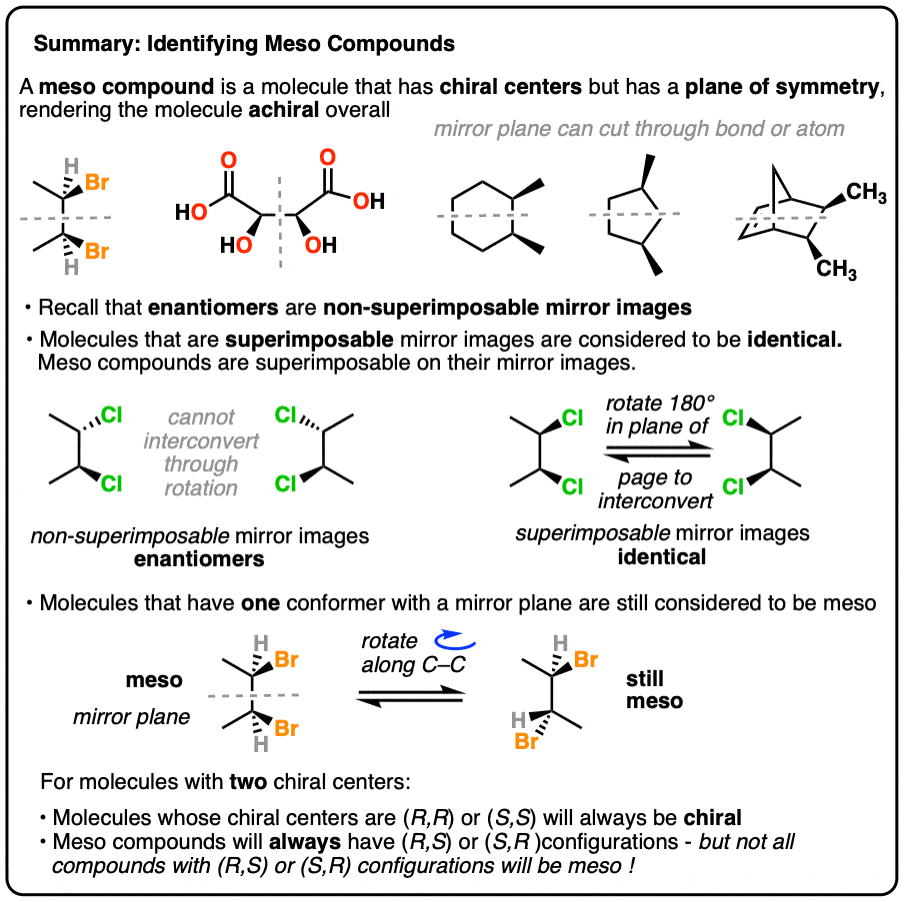
Table of Contents
-
- The Meso Trap
- But Clearly There Are No Mirror Planes In These Molecules…. (Right?)
- Fischer Projections, Newman Projections, and Cyclohexane Chairs
- Identifying Meso Compounds, Method One: Build A Model
- Identifying Meso Compounds, Method Two: Determine (R,S)
- Reviewing “Enantiomers, Diastereomers, or The Same” Questions
- Notes
- Quiz Yourself!
- (Advanced) References and Further Reading
1. The Meso Trap
Once you learn about stereochemistry, you’ll start getting asked to identify whether molecules are enantiomers, diastereomers, constitutional isomers or even identical. (See article: Enantiomers vs. Diastereomers vs. The Same – Two Methods for Solving Problems)
Most students by this point have it in their heads that enantiomers are mirror images.
So they are totally ripe for questions like this!
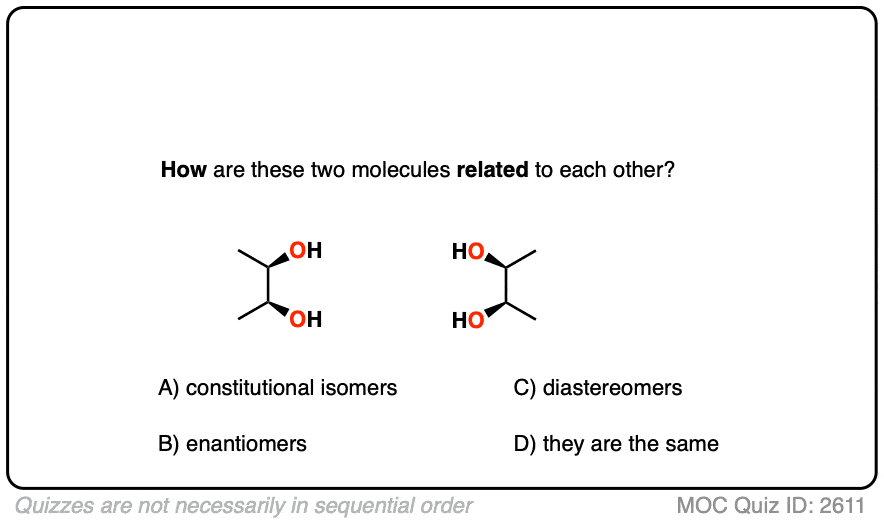 Click to Flip
Click to Flip
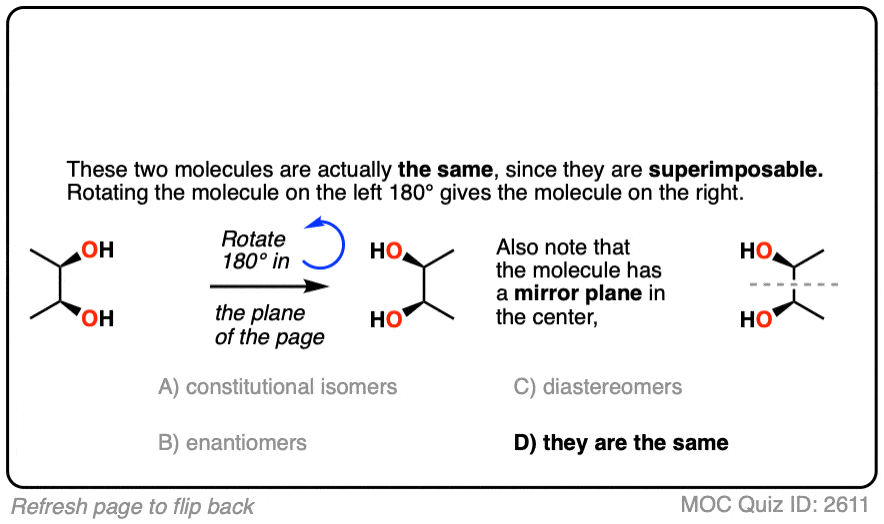
Ka-pow! These two molecules are drawn like they are mirror images of each other. But they are superimposable mirror images.
If you rotate the whole molecule on the left around, you can lay it right on top of the molecule on the left.
In organic chemistry, we have a name for two molecules that are superimposable. They are identical molecules.
Identical boiling point, freezing point, melting point – whatever physical property you care to name, they are indistinguishable.
What make the molecule above particularly tricky is that it does have two chiral centers. It’s just that those two chiral centers arranged on the molecule in a way that the molecule itself has an internal mirror plane, which renders the molecule achiral overall.
We call these molecules “meso compounds“.
[Louis Pasteur noted that there were three stereoisomers of tartaric acid. One rotated plane-polarized light to the left (levorotatory), one rotated plane polarized light to the right (dextrorotatory) and the third did not rotate plane-polarized light at all. This third stereoisomer, what we now call (2S, 3R)-tartaric acid, was called the “meso” (for “middle”). [See article – Optical Activity and Optical Rotation]
So I like to call questions like the one above, “Meso Traps”.
Here’s a similar question in this vein.
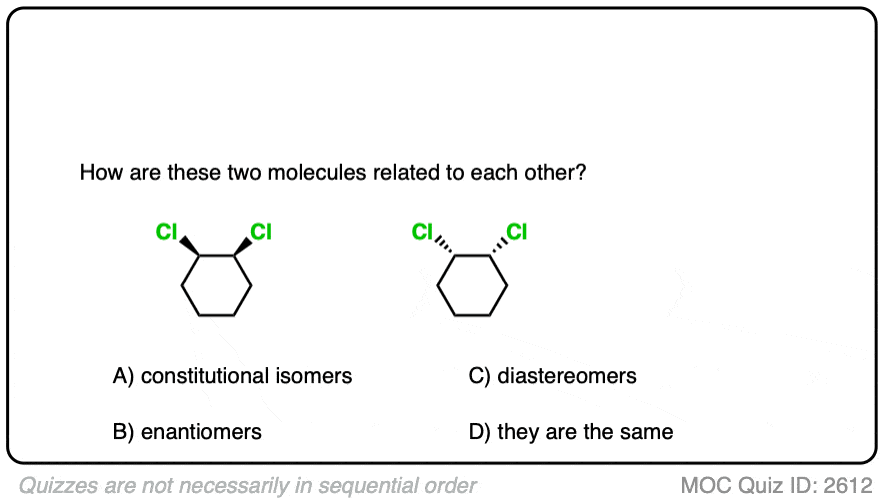 Click to Flip
Click to Flip
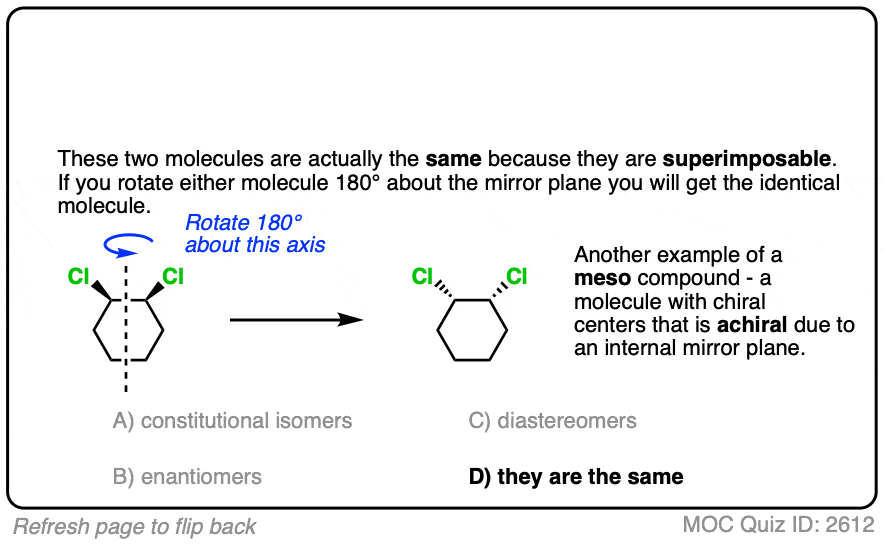
Now that you’ve done two, try this one.
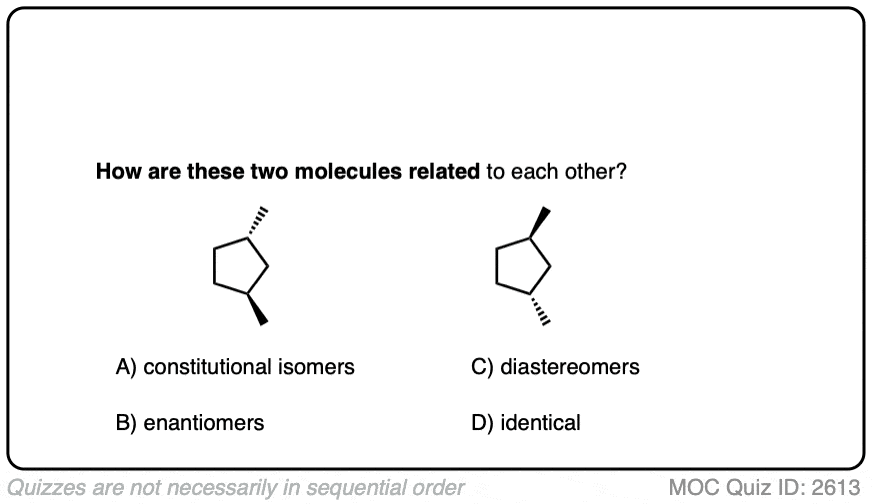 Click to Flip
Click to Flip
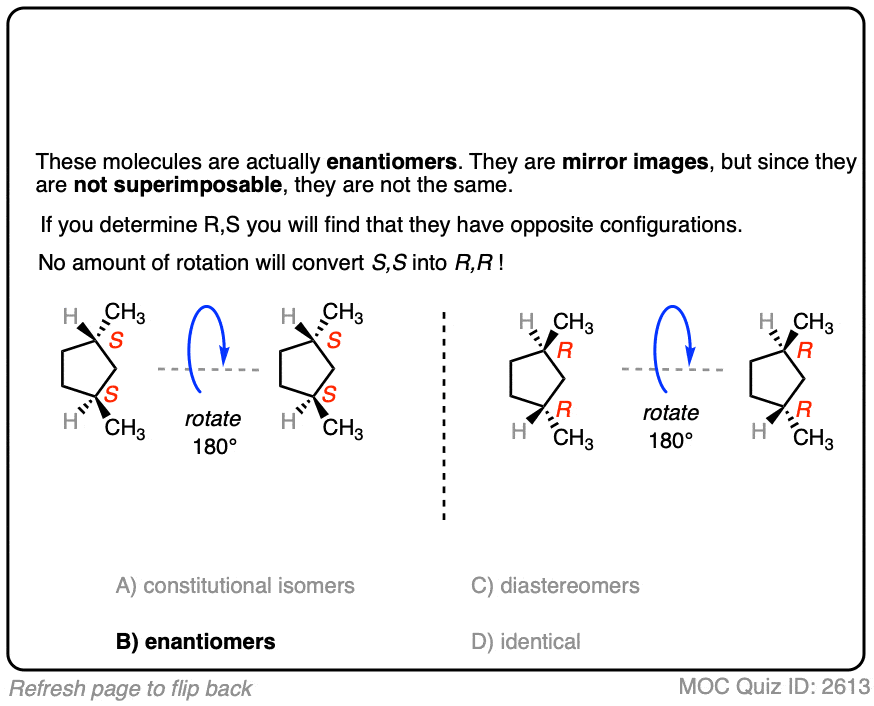
I can’t give you three Meso Traps in a row! That would make it too easy.
The point is to interleave trick questions with more straightforward ones.
Here’s another one for you.
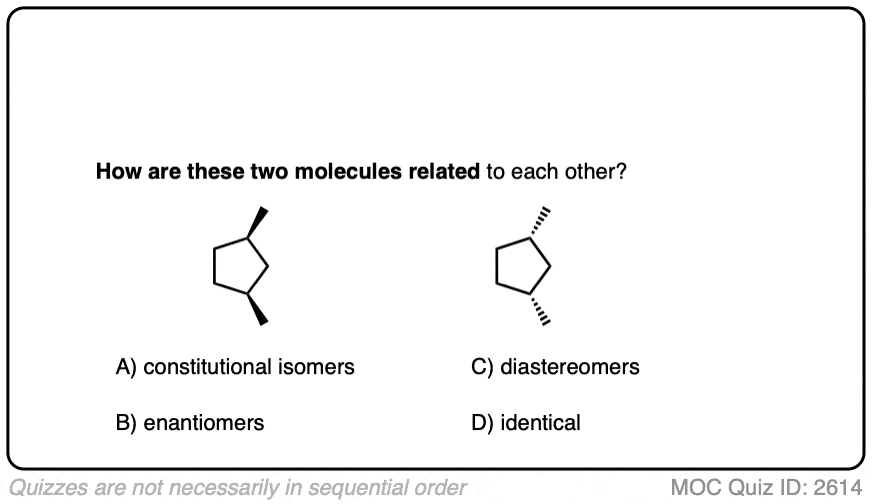 Click to Flip
Click to Flip
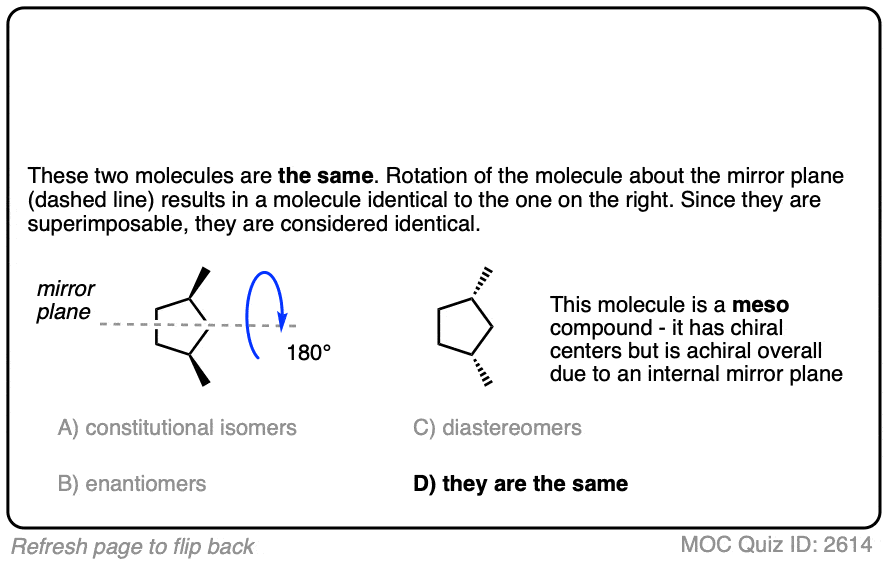
You get the idea. If a molecule has a mirror plane – and that mirror plane can cut through a bond or an atom – then it is an achiral molecule.
2. But Clearly There Are No Mirror Planes In These Molecules… (Right?)
Sometimes these questions are asked with a little bit more subtlety.
For example, what about these two molecules? Enantiomers, diastereomers, constitutional isomers, or something else?
Clearly, there’s no mirror plane in this molecule.
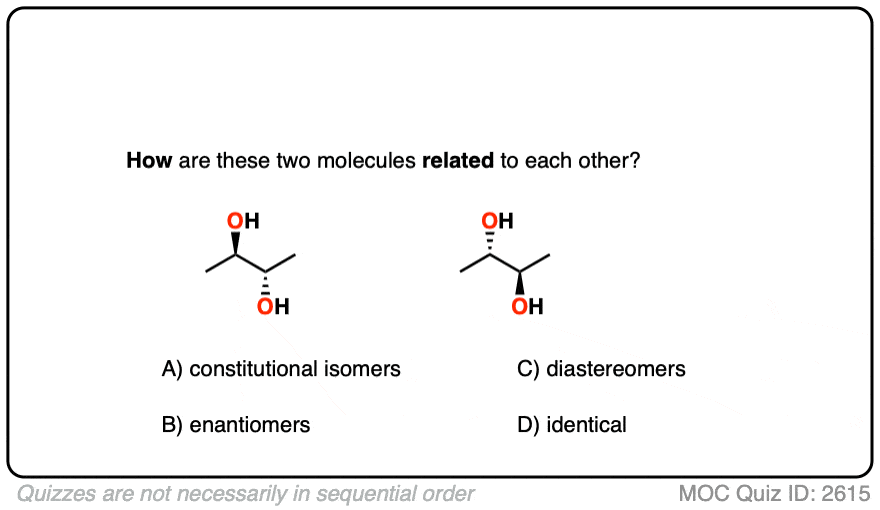 Click to Flip
Click to Flip
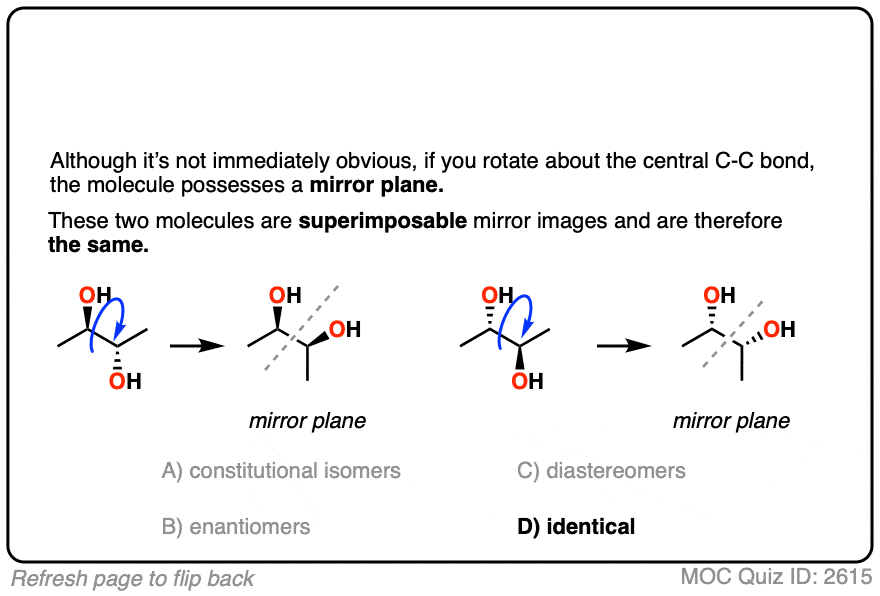
Or is there?
Don’t forget that molecules can adopt many different conformations through rotations about single bonds, and these conformations are all in equilibrium with each other. (See article: Newman Projection of Butane). So it’s very possible that you may be given examples where a bond rotation will reveal a plane of symmetry.
If a bond rotation creates a plane of symmetry in a molecule, that molecule is considered achiral.
In the case above, if you rotate the molecule along the central C-C bond, you’ll find that these molecules are actually exactly the same as those in the first question. It just takes a little bit more work to see it.
What about this example?
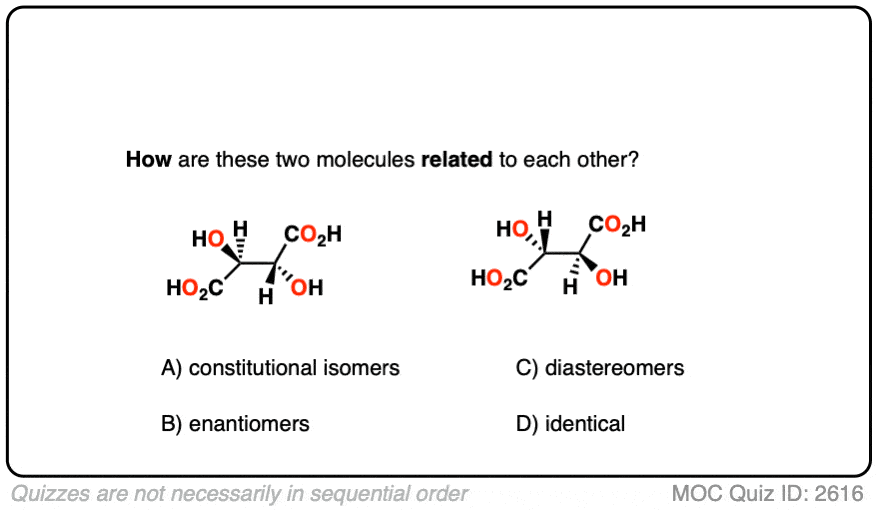 Click to Flip
Click to Flip
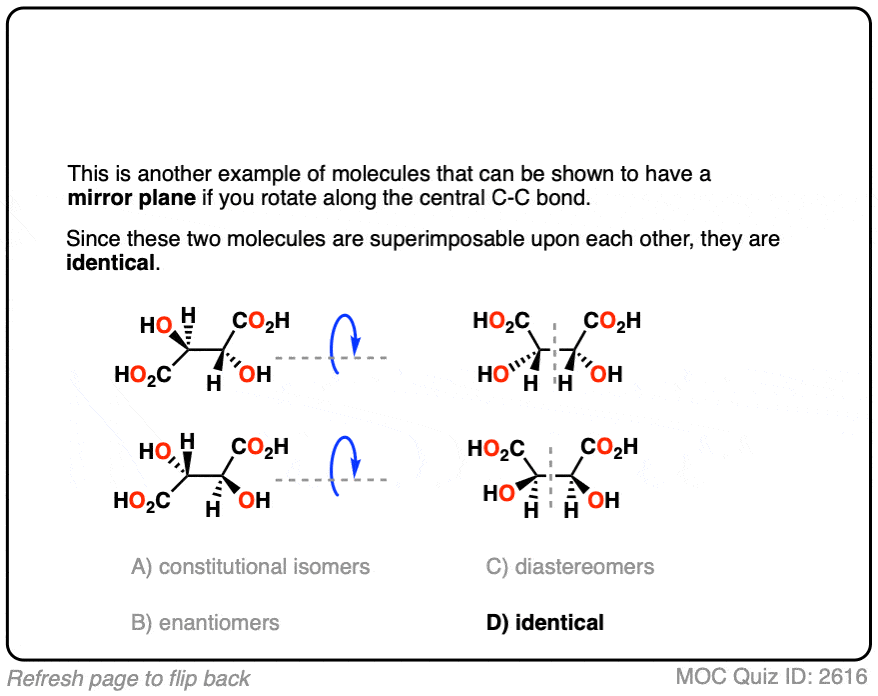
OK, another change of pace question. Those two are actually diastereomers.
What about these?
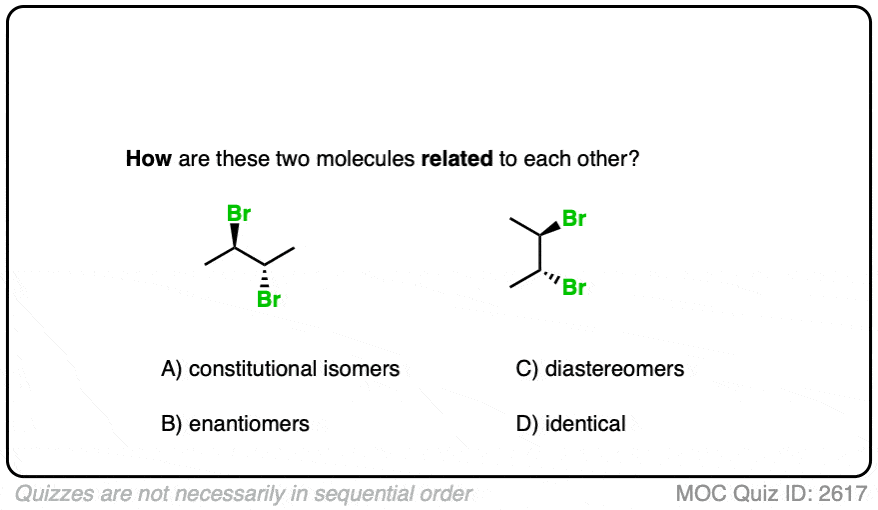 Click to Flip
Click to Flip

3. Fischer and Newman Projections
Let’s look at another set of questions. Remember that molecules won’t always be helpfully drawn as line diagrams. You can expect to see the full gamut of Newman, Fischer, Sawhorse, and even cyclohexane chair conformations.
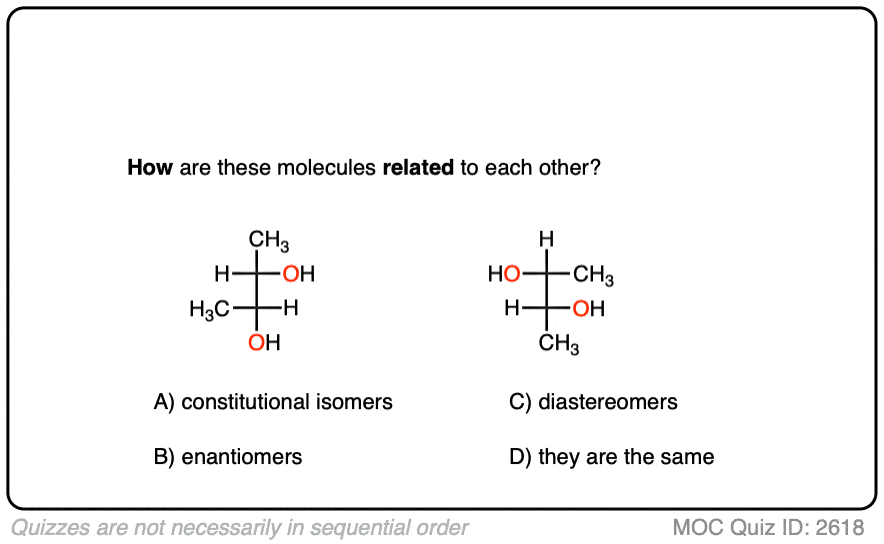 Click to Flip
Click to Flip
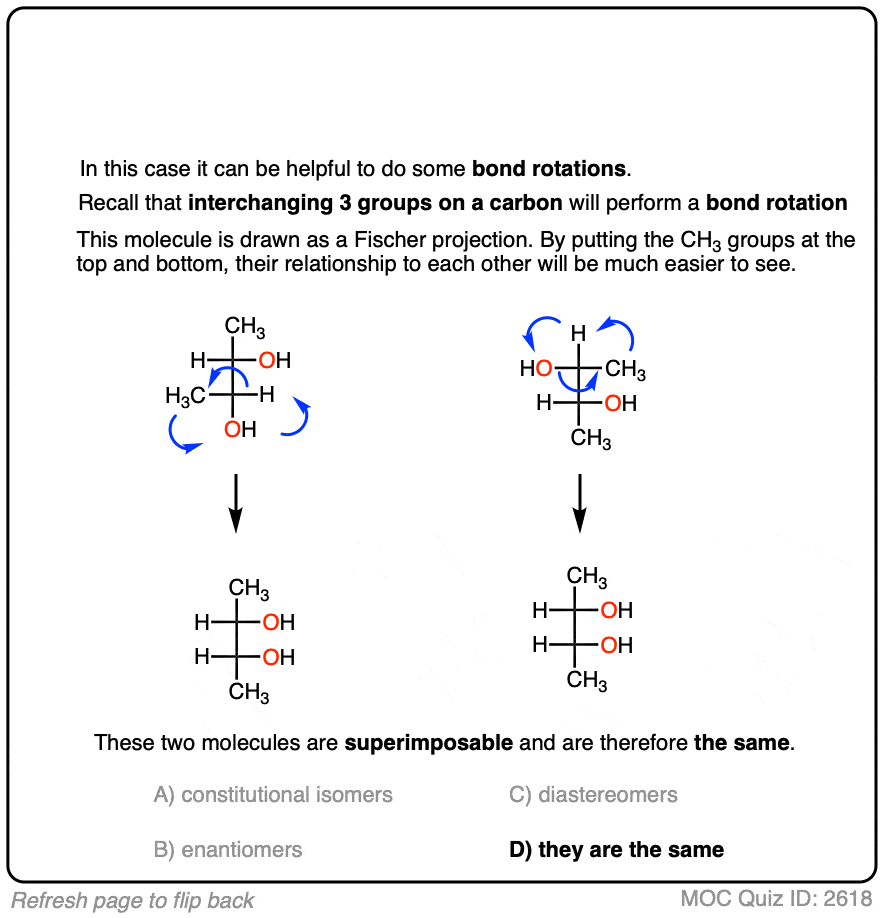
Sometimes I think that the only reason Fischer projections are still taught is that they give us instructors some variety in asking different stereochemistry questions.
A helpful trick to remember is that exchanging any three groups on a carbon results in doing a bond rotation.
(Swapping any two groups will swap the configuration of a chiral center from R to S or vice-versa – see The Single Swap Rule.
Let’s not forget Newman projections!
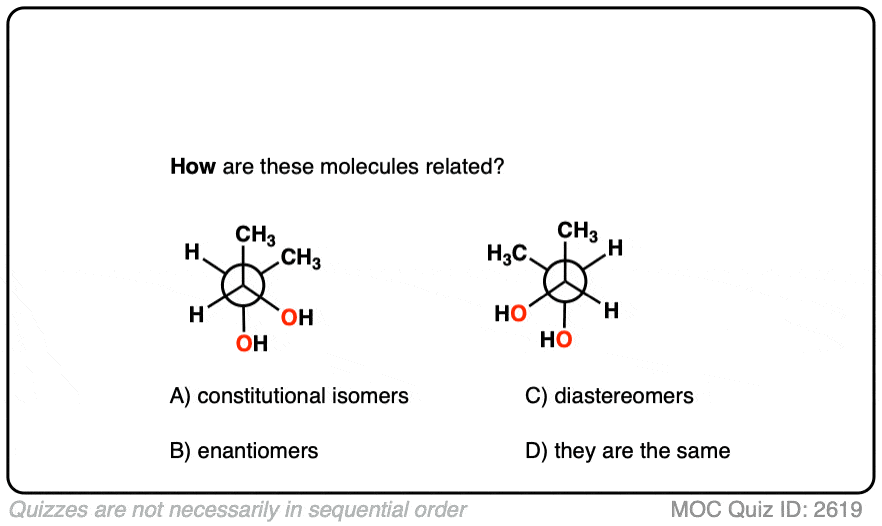 Click to Flip
Click to Flip
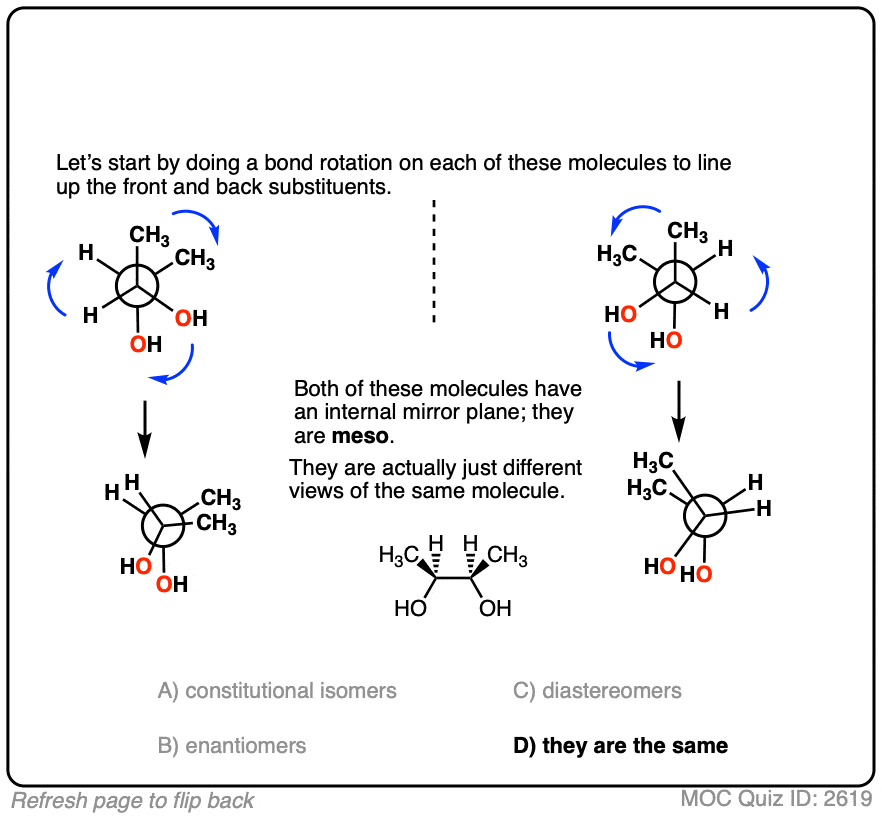
And cyclohexane chairs are also fair game.
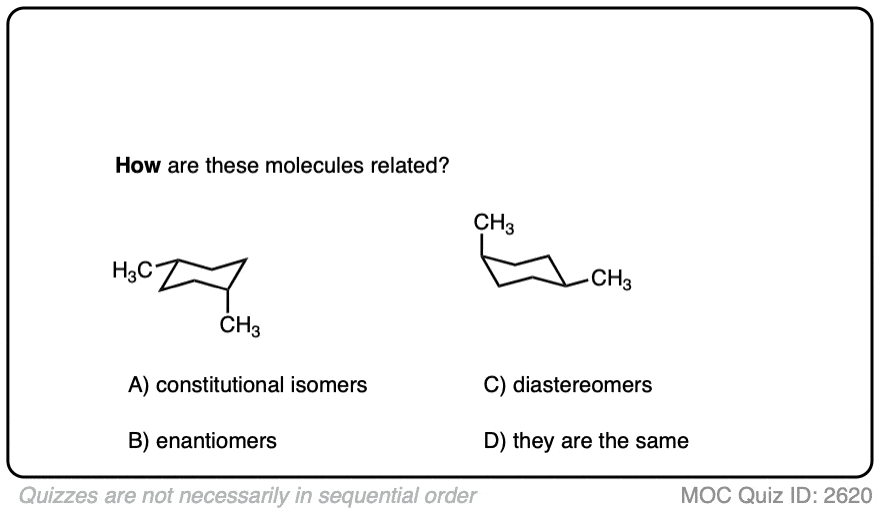 Click to Flip
Click to Flip
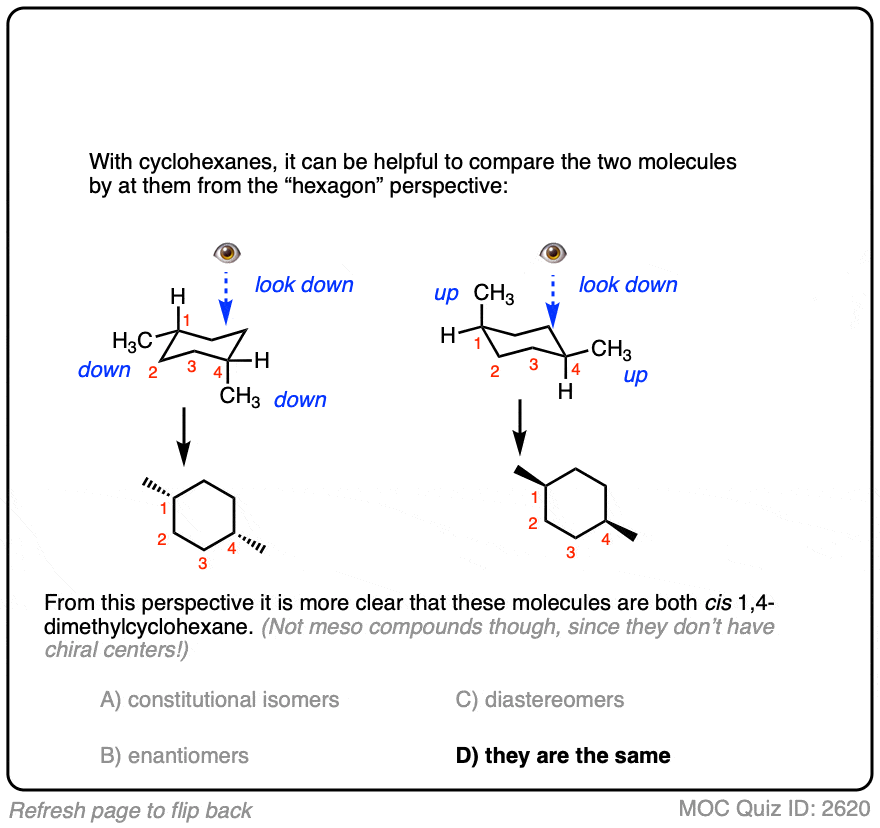
In this case, it helps to imagine what the molecule would look like when looking at it from above.
Remember that molecules are three-dimensional objects just like anything else and can be viewed from a variety of perspectives!
4. Identifying Meso Compounds, Method One: Build A Model
Now that most of the low-hanging fruit of trick questions has been thrown at you, let’s talk about strategies for identifying meso compounds and differentiating different kinds of stereoisomers.
There are two classes of strategies for solving these kinds of problems.
The first involves making a model, and then rotating along C-C bonds to find an axis of symmetry.
Here is an example of doing a bond rotation on a line diagram to reveal a plane of symmetry.
This also works for Fischer projections. Remember that in a Fischer, the arms come out to hug you (or strangle you, if you are feeling dark).
Newman projections can also be rotated, as in the short video below.
You get the idea. Build the two molecules with your model kit, rotate bonds until you can tell if they are superimposable or not.
5. Identifying Meso Compounds, Method Two: Determining Absolute Configuration (R,S)
Generations of students have been told to use model kits to visualize whether molecules are enantiomers, diastereomers, or the same.
And generations of students have rolled their eyes at this advice like they would at a parent admonishing their children to floss their teeth or eat their vegetables. They just don’t want to do it.
In my opinion, I think this is actually OK not to build models, provided that you practice like hell to get good at determining whether chiral centers are (R) or (S). Once you master the skill of determining absolute configuration (R/S), making a model is unnecessary.
That’s because there’s One Weird Trick that can help you determine which compounds are meso and which are not. It is also helpful for determining whether molecules are enantiomers, diastereomers, or the same.
Get ready for the One Weird Trick. Here we go.
Look at the R,S designations on these meso compounds, compared to their chiral diastereomers. What do you notice?
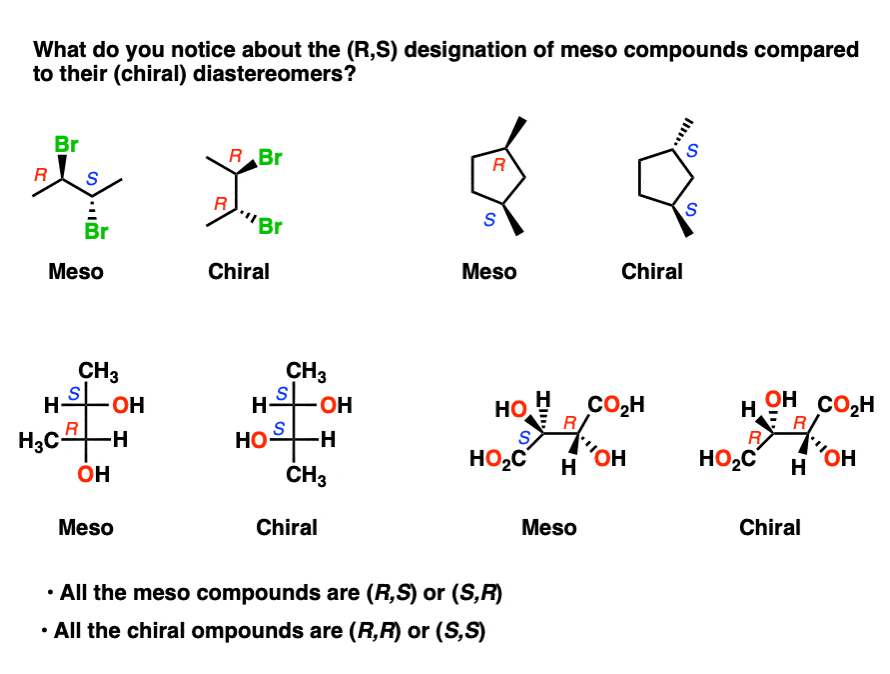
All the meso compounds are (R,S) or (S,R). Furthermore, the compounds that are (S,S) or (R,R) are never meso. They are chiral.
It makes sense when you think about it!
In a meso compound, the left-hand side of the molecule is the mirror image of the right hand side. In order for this to be true, a molecule with two chiral centers has to have two chiral centers that have opposite configurations – (R,S) or (S,R).
So one way to quickly determine if a compound is meso even if it’s drawn in a strange conformation is to determine (R,S) on each of the chiral centers. If it’s (R,S) or (S,R) your Meso Trap Alarm should be going off. [Note 1]
One word of caution: while it’s a necessary condition that a meso compound with two chiral centers must have (R,S) or (S,R) configurations it’s not a sufficient condition. The left-hand half must have the same connectivity as the right hand half.
You should double check that the molecule has the same connectivity on both sides before declaring it to be meso.
(2S, 3R)2-bromo-3-methylpentane is clearly not meso, for example, due to the fact that one chiral center has a bromine atom and the other does not.
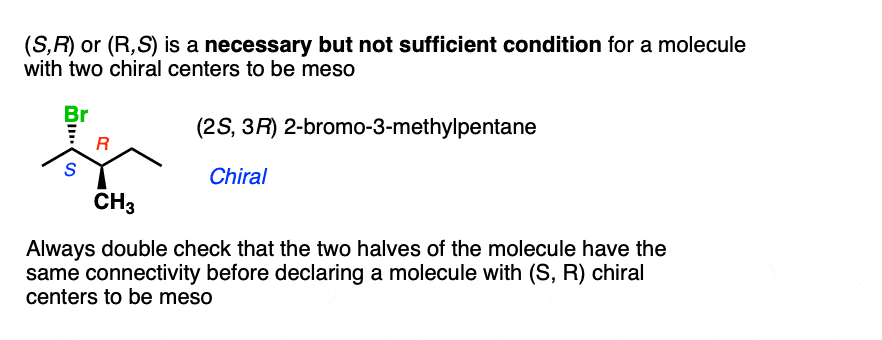
6. Reviewing “Enantiomers, Diastereomers, or The Same” Questions
In addition to sniffing out meso compounds, determining absolute configuration (R,S) is helpful in determining whether two molecules are enantiomers, diastereomers, or the same.
Just to review what we have covered elsewhere (see Enantiomers, Diastereomers, or the Same – Two Methods For Solving Problems)
For two molecules that have the same connectivity:
- If they have identical absolute configuration [e..g both (R,R), (S,S), or (S,R)] then they are considered to be identical.
- If one is (R,R) and the other is (S,S), they are enantiomers.
- If one is (R,R) or (S,S) and the other is (R,S) or (S,R), they are diastereomers since at least one of their chiral centers has an identical configuration.
- If one is (R,S) and the other is (S,R), they may be enantiomers, but they may also be meso compounds. Double check the connectivity to see if a plane of symmetry may be possible. If they are both meso, then they are considered to be identical.
Good luck – and may you avoid falling into the Meso Trap!
Notes
Related Articles
- Optical Rotation, Optical Activity, and Specific Rotation
- Optical Purity and Enantiomeric Excess
- Enantiomers vs Diastereomers vs The Same? Two Methods For Solving Problems
- What’s a Racemic Mixture?
- How To Determine R and S Configurations On A Fischer Projection
- Assigning R/S To Newman Projections (And Converting Newman To Line Diagrams)
- Types of Isomers: Constitutional Isomers, Stereoisomers, Enantiomers, and Diastereomers
- Stereochemistry Practice Problems and Quizzes (MOC Membership)
- How To Draw The Enantiomer Of A Chiral Molecule
- How To Draw A Bond Rotation
Significantly updated Oct 2023 from a previous version
Note 1. This also applies to meso compounds with more than two chiral centers.
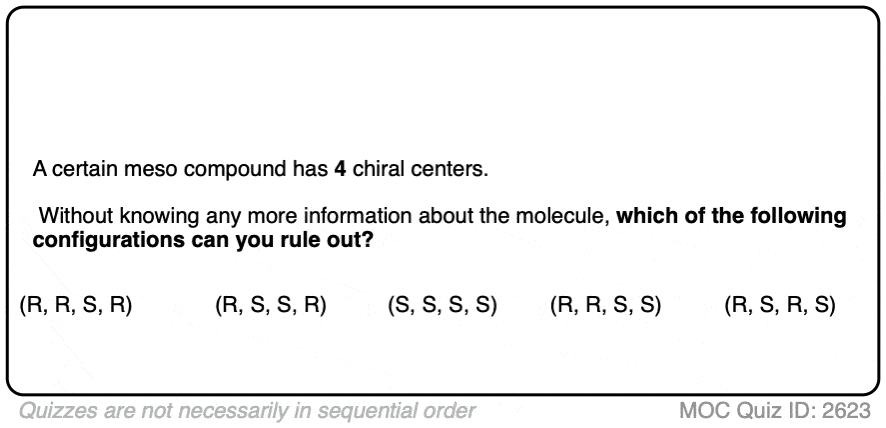 Click to Flip
Click to Flip
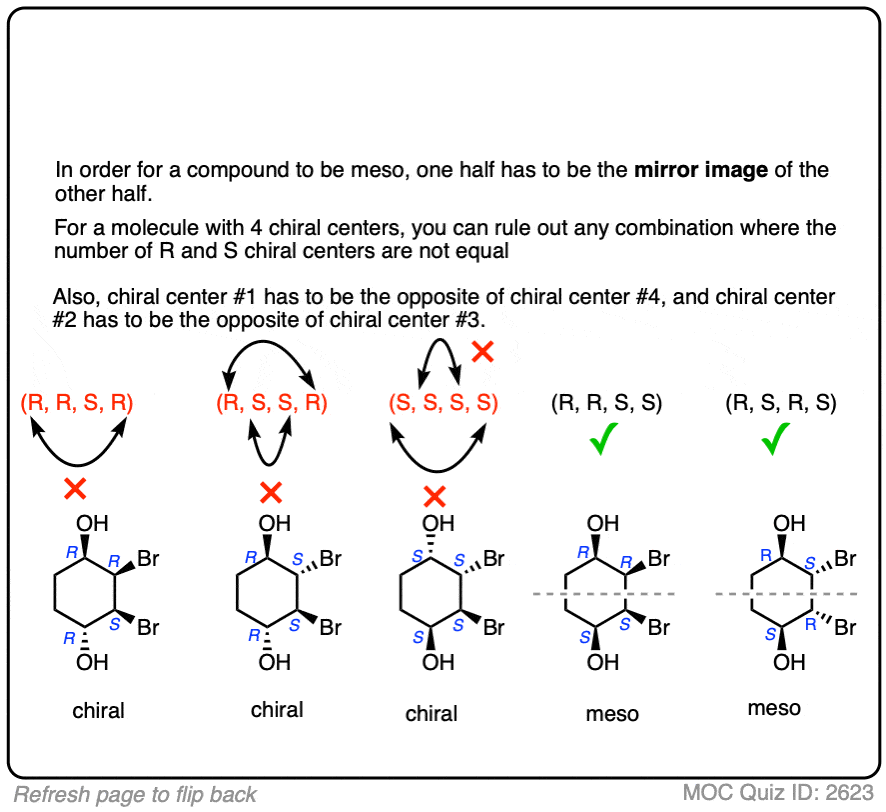
The largest meso compound I am aware of is nonactin. Despite having 16 chiral centers, it has a plane of symmetry and is achiral overall.
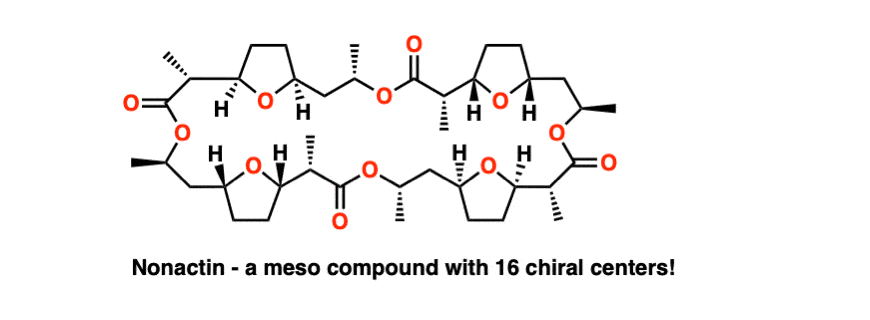
The assignment of chiral centers in nonactin is (R,R,R,R, S, S, S, S, R, R, R, R, S, S, S, S) – an equal number of (R) and (S) chiral centers, and the left half is the mirror image of the right half. [Source]
Quiz Yourself!
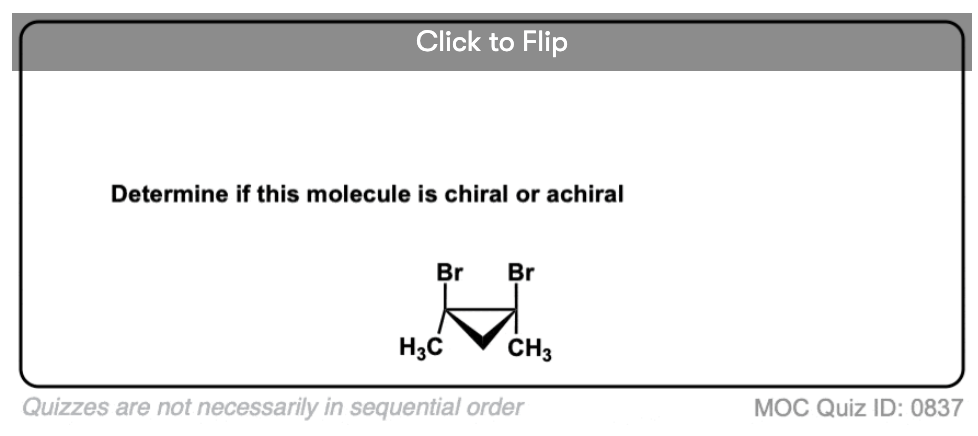
Become a MOC member to see the clickable quiz with answers on the back.
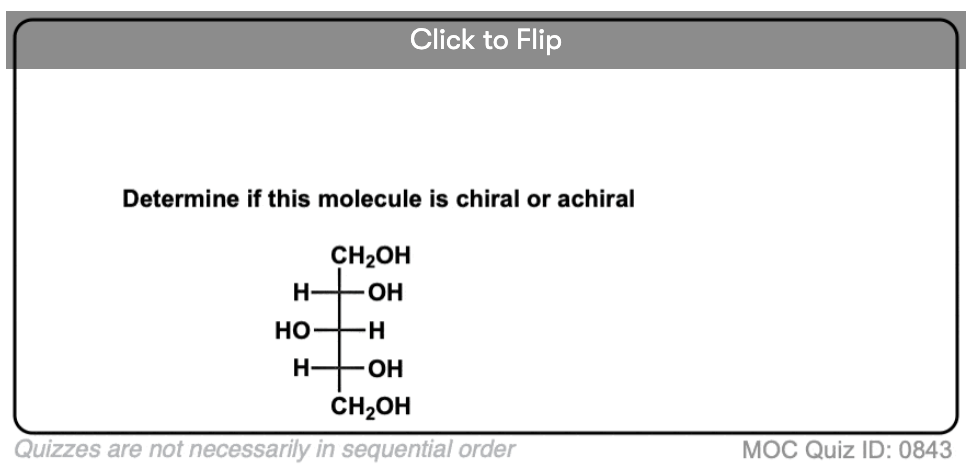
Become a MOC member to see the clickable quiz with answers on the back.
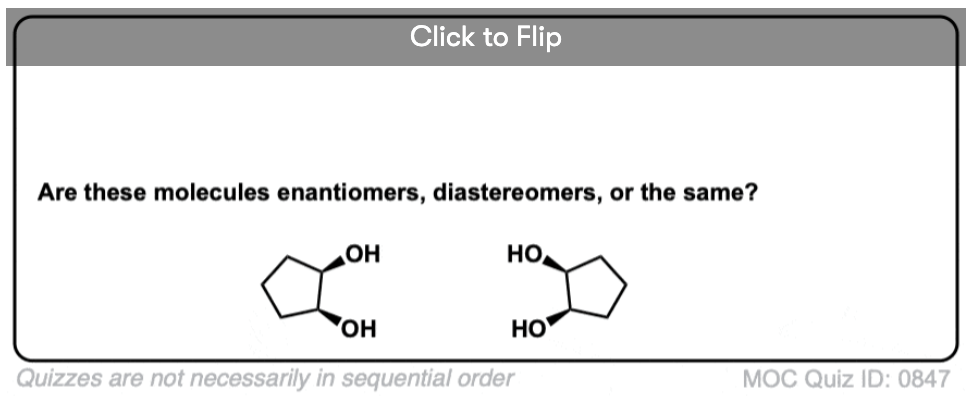
Become a MOC member to see the clickable quiz with answers on the back.
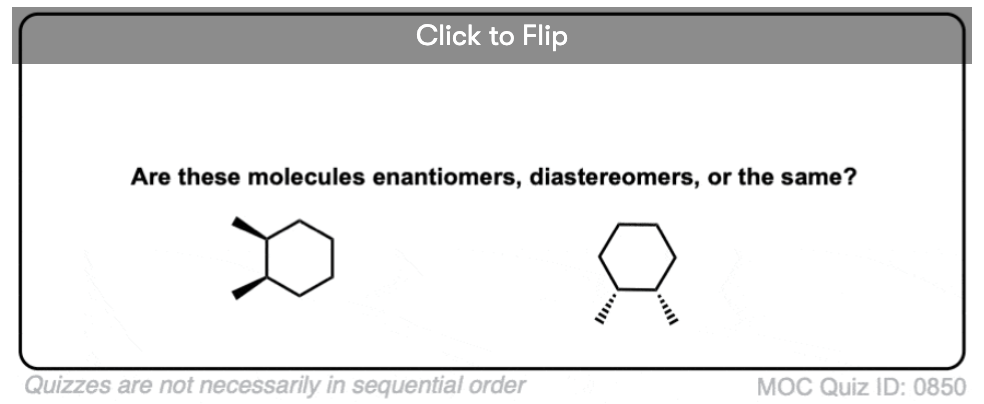
Become a MOC member to see the clickable quiz with answers on the back.
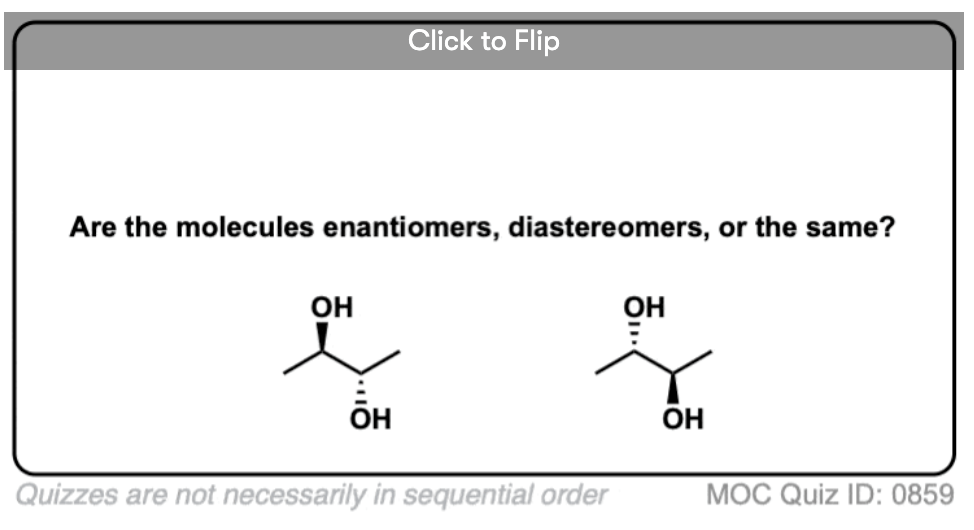
Become a MOC member to see the clickable quiz with answers on the back.
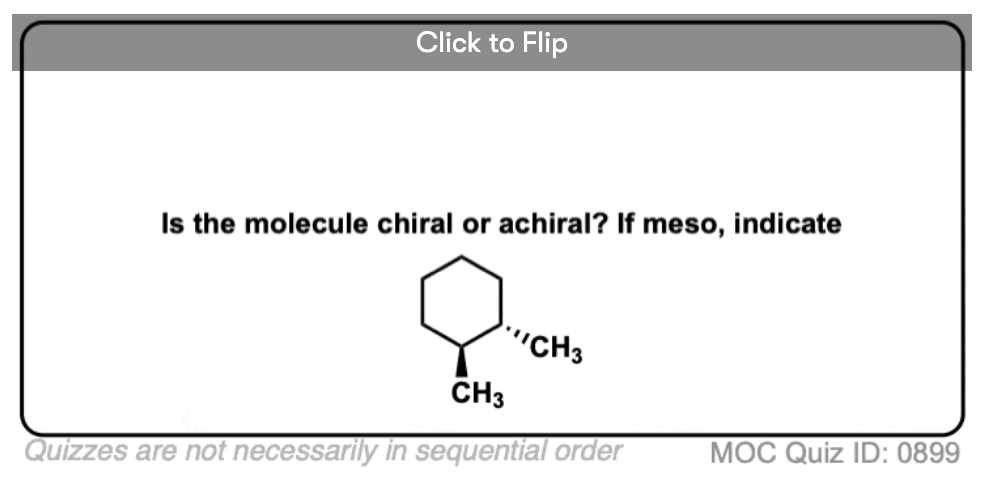
Become a MOC member to see the clickable quiz with answers on the back.
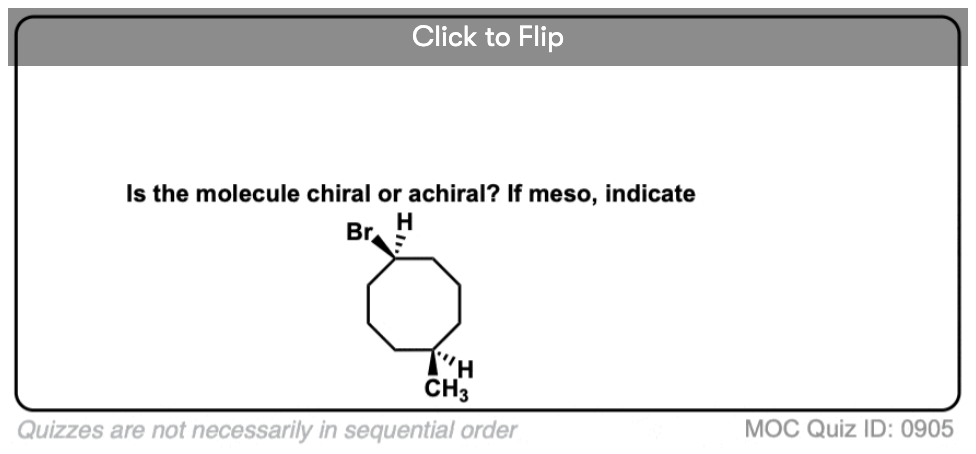
Become a MOC member to see the clickable quiz with answers on the back.
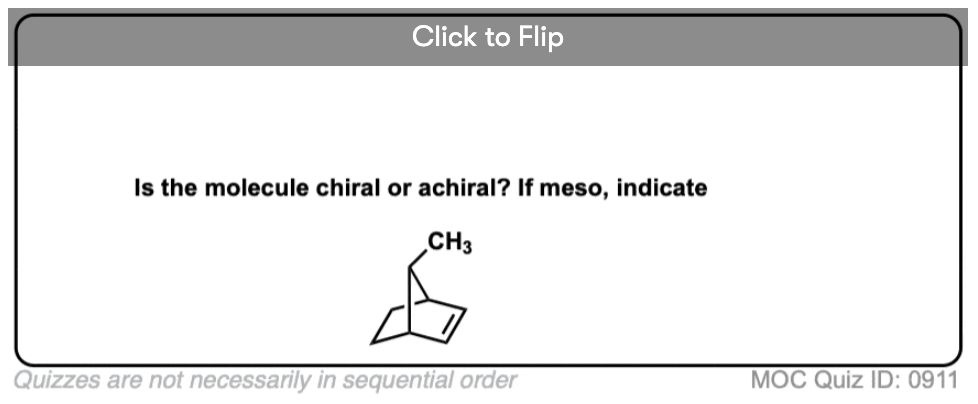
Become a MOC member to see the clickable quiz with answers on the back.
(Advanced) References and Further Reading
[references]
00 General Chemistry Review
01 Bonding, Structure, and Resonance
- How Do We Know Methane (CH4) Is Tetrahedral?
- Hybrid Orbitals and Hybridization
- How To Determine Hybridization: A Shortcut
- Orbital Hybridization And Bond Strengths
- Sigma bonds come in six varieties: Pi bonds come in one
- Dipole Moments and Dipoles
- A Key Skill: How to Calculate Formal Charge
- The Four Intermolecular Forces and How They Affect Boiling Points
- 3 Trends That Affect Boiling Points
- How To Use Electronegativity To Determine Electron Density (and why NOT to trust formal charge)
- Introduction to Resonance
- How To Use Curved Arrows To Interchange Resonance Forms
- Evaluating Resonance Forms (1) - The Rule of Least Charges
- How To Find The Best Resonance Structure By Applying Electronegativity
- Evaluating Resonance Structures With Negative Charges
- Evaluating Resonance Structures With Positive Charge
- Exploring Resonance: Pi-Donation
- Exploring Resonance: Pi-acceptors
- In Summary: Evaluating Resonance Structures
- Drawing Resonance Structures: 3 Common Mistakes To Avoid
- How to apply electronegativity and resonance to understand reactivity
- Bond Hybridization Practice
- Structure and Bonding Practice Quizzes
- Resonance Structures Practice
02 Acid Base Reactions
- Introduction to Acid-Base Reactions
- Acid Base Reactions In Organic Chemistry
- The Stronger The Acid, The Weaker The Conjugate Base
- Walkthrough of Acid-Base Reactions (3) - Acidity Trends
- Five Key Factors That Influence Acidity
- Acid-Base Reactions: Introducing Ka and pKa
- How to Use a pKa Table
- The pKa Table Is Your Friend
- A Handy Rule of Thumb for Acid-Base Reactions
- Acid Base Reactions Are Fast
- pKa Values Span 60 Orders Of Magnitude
- How Protonation and Deprotonation Affect Reactivity
- Acid Base Practice Problems
03 Alkanes and Nomenclature
- Meet the (Most Important) Functional Groups
- Condensed Formulas: Deciphering What the Brackets Mean
- Hidden Hydrogens, Hidden Lone Pairs, Hidden Counterions
- Don't Be Futyl, Learn The Butyls
- Primary, Secondary, Tertiary, Quaternary In Organic Chemistry
- Branching, and Its Affect On Melting and Boiling Points
- The Many, Many Ways of Drawing Butane
- Wedge And Dash Convention For Tetrahedral Carbon
- Common Mistakes in Organic Chemistry: Pentavalent Carbon
- Table of Functional Group Priorities for Nomenclature
- Summary Sheet - Alkane Nomenclature
- Organic Chemistry IUPAC Nomenclature Demystified With A Simple Puzzle Piece Approach
- Boiling Point Quizzes
- Organic Chemistry Nomenclature Quizzes
04 Conformations and Cycloalkanes
- Staggered vs Eclipsed Conformations of Ethane
- Conformational Isomers of Propane
- Newman Projection of Butane (and Gauche Conformation)
- Introduction to Cycloalkanes
- Geometric Isomers In Small Rings: Cis And Trans Cycloalkanes
- Calculation of Ring Strain In Cycloalkanes
- Cycloalkanes - Ring Strain In Cyclopropane And Cyclobutane
- Cyclohexane Conformations
- Cyclohexane Chair Conformation: An Aerial Tour
- How To Draw The Cyclohexane Chair Conformation
- The Cyclohexane Chair Flip
- The Cyclohexane Chair Flip - Energy Diagram
- Substituted Cyclohexanes - Axial vs Equatorial
- Ranking The Bulkiness Of Substituents On Cyclohexanes: "A-Values"
- Cyclohexane Chair Conformation Stability: Which One Is Lower Energy?
- Fused Rings - Cis-Decalin and Trans-Decalin
- Naming Bicyclic Compounds - Fused, Bridged, and Spiro
- Bredt's Rule (And Summary of Cycloalkanes)
- Newman Projection Practice
- Cycloalkanes Practice Problems
05 A Primer On Organic Reactions
- The Most Important Question To Ask When Learning a New Reaction
- Curved Arrows (for reactions)
- Nucleophiles and Electrophiles
- The Three Classes of Nucleophiles
- Nucleophilicity vs. Basicity
- What Makes A Good Nucleophile?
- What Makes A Good Leaving Group?
- 3 Factors That Stabilize Carbocations
- Equilibrium and Energy Relationships
- 7 Factors that stabilize negative charge in organic chemistry
- 7 Factors That Stabilize Positive Charge in Organic Chemistry
- What's a Transition State?
- Hammond's Postulate
- Learning Organic Chemistry Reactions: A Checklist (PDF)
06 Free Radical Reactions
- Free Radical Reactions
- 3 Factors That Stabilize Free Radicals
- Bond Strengths And Radical Stability
- Free Radical Initiation: Why Is "Light" Or "Heat" Required?
- Initiation, Propagation, Termination
- Monochlorination Products Of Propane, Pentane, And Other Alkanes
- Selectivity In Free Radical Reactions
- Selectivity in Free Radical Reactions: Bromination vs. Chlorination
- Halogenation At Tiffany's
- Allylic Bromination
- Bonus Topic: Allylic Rearrangements
- In Summary: Free Radicals
- Synthesis (2) - Reactions of Alkanes
- Free Radicals Practice Quizzes
07 Stereochemistry and Chirality
- Types of Isomers: Constitutional Isomers, Stereoisomers, Enantiomers, and Diastereomers
- How To Draw The Enantiomer Of A Chiral Molecule
- How To Draw A Bond Rotation
- Introduction to Assigning (R) and (S): The Cahn-Ingold-Prelog Rules
- Assigning Cahn-Ingold-Prelog (CIP) Priorities (2) - The Method of Dots
- Enantiomers vs Diastereomers vs The Same? Two Methods For Solving Problems
- Assigning R/S To Newman Projections (And Converting Newman To Line Diagrams)
- How To Determine R and S Configurations On A Fischer Projection
- The Meso Trap
- Optical Rotation, Optical Activity, and Specific Rotation
- Optical Purity and Enantiomeric Excess
- What's a Racemic Mixture?
- Chiral Allenes And Chiral Axes
- Stereochemistry Practice Problems and Quizzes
08 Substitution Reactions
- Nucleophilic Substitution Reactions - Introduction
- Two Types of Nucleophilic Substitution Reactions
- The SN2 Mechanism
- Why the SN2 Reaction Is Powerful
- The SN1 Mechanism
- The Conjugate Acid Is A Better Leaving Group
- Comparing the SN1 and SN2 Reactions
- Polar Protic? Polar Aprotic? Nonpolar? All About Solvents
- Steric Hindrance is Like a Fat Goalie
- Common Blind Spot: Intramolecular Reactions
- Substitution Practice - SN1
- Substitution Practice - SN2
09 Elimination Reactions
- Elimination Reactions (1): Introduction And The Key Pattern
- Elimination Reactions (2): The Zaitsev Rule
- Elimination Reactions Are Favored By Heat
- Two Elimination Reaction Patterns
- The E1 Reaction
- The E2 Mechanism
- E1 vs E2: Comparing the E1 and E2 Reactions
- Antiperiplanar Relationships: The E2 Reaction and Cyclohexane Rings
- Bulky Bases in Elimination Reactions
- Comparing the E1 vs SN1 Reactions
- Elimination (E1) Reactions With Rearrangements
- E1cB - Elimination (Unimolecular) Conjugate Base
- Elimination (E1) Practice Problems And Solutions
- Elimination (E2) Practice Problems and Solutions
10 Rearrangements
11 SN1/SN2/E1/E2 Decision
- Identifying Where Substitution and Elimination Reactions Happen
- Deciding SN1/SN2/E1/E2 (1) - The Substrate
- Deciding SN1/SN2/E1/E2 (2) - The Nucleophile/Base
- SN1 vs E1 and SN2 vs E2 : The Temperature
- Deciding SN1/SN2/E1/E2 - The Solvent
- Wrapup: The Key Factors For Determining SN1/SN2/E1/E2
- Alkyl Halide Reaction Map And Summary
- SN1 SN2 E1 E2 Practice Problems
12 Alkene Reactions
- E and Z Notation For Alkenes (+ Cis/Trans)
- Alkene Stability
- Alkene Addition Reactions: "Regioselectivity" and "Stereoselectivity" (Syn/Anti)
- Stereoselective and Stereospecific Reactions
- Hydrohalogenation of Alkenes and Markovnikov's Rule
- Hydration of Alkenes With Aqueous Acid
- Rearrangements in Alkene Addition Reactions
- Halogenation of Alkenes and Halohydrin Formation
- Oxymercuration Demercuration of Alkenes
- Hydroboration Oxidation of Alkenes
- m-CPBA (meta-chloroperoxybenzoic acid)
- OsO4 (Osmium Tetroxide) for Dihydroxylation of Alkenes
- Palladium on Carbon (Pd/C) for Catalytic Hydrogenation of Alkenes
- Cyclopropanation of Alkenes
- A Fourth Alkene Addition Pattern - Free Radical Addition
- Alkene Reactions: Ozonolysis
- Oxidative Cleavage of Vicinal Diols With NaIO4 and Pb(OAc)4
- Summary: Three Key Families Of Alkene Reaction Mechanisms
- Synthesis (4) - Alkene Reaction Map, Including Alkyl Halide Reactions
- Alkene Reactions Practice Problems
13 Alkyne Reactions
- Acetylides from Alkynes, And Substitution Reactions of Acetylides
- Partial Reduction of Alkynes With Lindlar's Catalyst
- Partial Reduction of Alkynes With Na/NH3 To Obtain Trans Alkenes
- Alkyne Hydroboration With "R2BH"
- Hydration and Oxymercuration of Alkynes
- Hydrohalogenation of Alkynes
- Alkyne Halogenation: Bromination and Chlorination of Alkynes
- Oxidation of Alkynes With O3 and KMnO4
- Alkenes To Alkynes Via Halogenation And Elimination Reactions
- Alkynes Are A Blank Canvas
- Synthesis (5) - Reactions of Alkynes
- Alkyne Reactions Practice Problems With Answers
14 Alcohols, Epoxides and Ethers
- Alcohols - Nomenclature and Properties
- Alcohols Can Act As Acids Or Bases (And Why It Matters)
- Alcohols - Acidity and Basicity
- The Williamson Ether Synthesis
- Ethers From Alkenes, Tertiary Alkyl Halides and Alkoxymercuration
- Alcohols To Ethers via Acid Catalysis
- Cleavage Of Ethers With Acid
- Epoxides - The Outlier Of The Ether Family
- Opening of Epoxides With Acid
- Epoxide Ring Opening With Base
- Making Alkyl Halides From Alcohols
- Tosylates And Mesylates
- PBr3 and SOCl2
- Elimination Reactions of Alcohols
- Elimination of Alcohols To Alkenes With POCl3
- Alcohol Oxidation: "Strong" and "Weak" Oxidants
- Demystifying The Mechanisms of Alcohol Oxidations
- Protecting Groups For Alcohols
- Thiols And Thioethers
- Calculating the oxidation state of a carbon
- Oxidation and Reduction in Organic Chemistry
- Oxidation Ladders
- SOCl2 Mechanism For Alcohols To Alkyl Halides: SN2 versus SNi
- Alcohol Reactions Roadmap (PDF)
- Alcohol Reaction Practice Problems
- Epoxide Reaction Quizzes
- Oxidation and Reduction Practice Quizzes
15 Organometallics
- What's An Organometallic?
- Formation of Grignard and Organolithium Reagents
- Organometallics Are Strong Bases
- Reactions of Grignard Reagents
- Protecting Groups In Grignard Reactions
- Synthesis Problems Involving Grignard Reagents
- Grignard Reactions And Synthesis (2)
- Organocuprates (Gilman Reagents): How They're Made
- Gilman Reagents (Organocuprates): What They're Used For
- The Heck, Suzuki, and Olefin Metathesis Reactions (And Why They Don't Belong In Most Introductory Organic Chemistry Courses)
- Reaction Map: Reactions of Organometallics
- Grignard Practice Problems
16 Spectroscopy
- Degrees of Unsaturation (or IHD, Index of Hydrogen Deficiency)
- Conjugation And Color (+ How Bleach Works)
- Introduction To UV-Vis Spectroscopy
- UV-Vis Spectroscopy: Absorbance of Carbonyls
- UV-Vis Spectroscopy: Practice Questions
- Bond Vibrations, Infrared Spectroscopy, and the "Ball and Spring" Model
- Infrared (IR) Spectroscopy: A Quick Primer On Interpreting Spectra
- IR Spectroscopy: 4 Practice Problems
- 1H NMR: How Many Signals?
- Homotopic, Enantiotopic, Diastereotopic
- Diastereotopic Protons in 1H NMR Spectroscopy: Examples
- 13-C NMR - How Many Signals
- Liquid Gold: Pheromones In Doe Urine
- Natural Product Isolation (1) - Extraction
- Natural Product Isolation (2) - Purification Techniques, An Overview
- Structure Determination Case Study: Deer Tarsal Gland Pheromone
17 Dienes and MO Theory
- What To Expect In Organic Chemistry 2
- Are these molecules conjugated?
- Conjugation And Resonance In Organic Chemistry
- Bonding And Antibonding Pi Orbitals
- Molecular Orbitals of The Allyl Cation, Allyl Radical, and Allyl Anion
- Pi Molecular Orbitals of Butadiene
- Reactions of Dienes: 1,2 and 1,4 Addition
- Thermodynamic and Kinetic Products
- More On 1,2 and 1,4 Additions To Dienes
- s-cis and s-trans
- The Diels-Alder Reaction
- Cyclic Dienes and Dienophiles in the Diels-Alder Reaction
- Stereochemistry of the Diels-Alder Reaction
- Exo vs Endo Products In The Diels Alder: How To Tell Them Apart
- HOMO and LUMO In the Diels Alder Reaction
- Why Are Endo vs Exo Products Favored in the Diels-Alder Reaction?
- Diels-Alder Reaction: Kinetic and Thermodynamic Control
- The Retro Diels-Alder Reaction
- The Intramolecular Diels Alder Reaction
- Regiochemistry In The Diels-Alder Reaction
- The Cope and Claisen Rearrangements
- Electrocyclic Reactions
- Electrocyclic Ring Opening And Closure (2) - Six (or Eight) Pi Electrons
- Diels Alder Practice Problems
- Molecular Orbital Theory Practice
18 Aromaticity
- Introduction To Aromaticity
- Rules For Aromaticity
- Huckel's Rule: What Does 4n+2 Mean?
- Aromatic, Non-Aromatic, or Antiaromatic? Some Practice Problems
- Antiaromatic Compounds and Antiaromaticity
- The Pi Molecular Orbitals of Benzene
- The Pi Molecular Orbitals of Cyclobutadiene
- Frost Circles
- Aromaticity Practice Quizzes
19 Reactions of Aromatic Molecules
- Electrophilic Aromatic Substitution: Introduction
- Activating and Deactivating Groups In Electrophilic Aromatic Substitution
- Electrophilic Aromatic Substitution - The Mechanism
- Ortho-, Para- and Meta- Directors in Electrophilic Aromatic Substitution
- Understanding Ortho, Para, and Meta Directors
- Why are halogens ortho- para- directors?
- Disubstituted Benzenes: The Strongest Electron-Donor "Wins"
- Electrophilic Aromatic Substitutions (1) - Halogenation of Benzene
- Electrophilic Aromatic Substitutions (2) - Nitration and Sulfonation
- EAS Reactions (3) - Friedel-Crafts Acylation and Friedel-Crafts Alkylation
- Intramolecular Friedel-Crafts Reactions
- Nucleophilic Aromatic Substitution (NAS)
- Nucleophilic Aromatic Substitution (2) - The Benzyne Mechanism
- Reactions on the "Benzylic" Carbon: Bromination And Oxidation
- The Wolff-Kishner, Clemmensen, And Other Carbonyl Reductions
- More Reactions on the Aromatic Sidechain: Reduction of Nitro Groups and the Baeyer Villiger
- Aromatic Synthesis (1) - "Order Of Operations"
- Synthesis of Benzene Derivatives (2) - Polarity Reversal
- Aromatic Synthesis (3) - Sulfonyl Blocking Groups
- Birch Reduction
- Synthesis (7): Reaction Map of Benzene and Related Aromatic Compounds
- Aromatic Reactions and Synthesis Practice
- Electrophilic Aromatic Substitution Practice Problems
20 Aldehydes and Ketones
- What's The Alpha Carbon In Carbonyl Compounds?
- Nucleophilic Addition To Carbonyls
- Aldehydes and Ketones: 14 Reactions With The Same Mechanism
- Sodium Borohydride (NaBH4) Reduction of Aldehydes and Ketones
- Grignard Reagents For Addition To Aldehydes and Ketones
- Wittig Reaction
- Hydrates, Hemiacetals, and Acetals
- Imines - Properties, Formation, Reactions, and Mechanisms
- All About Enamines
- Breaking Down Carbonyl Reaction Mechanisms: Reactions of Anionic Nucleophiles (Part 2)
- Aldehydes Ketones Reaction Practice
21 Carboxylic Acid Derivatives
- Nucleophilic Acyl Substitution (With Negatively Charged Nucleophiles)
- Addition-Elimination Mechanisms With Neutral Nucleophiles (Including Acid Catalysis)
- Basic Hydrolysis of Esters - Saponification
- Transesterification
- Proton Transfer
- Fischer Esterification - Carboxylic Acid to Ester Under Acidic Conditions
- Lithium Aluminum Hydride (LiAlH4) For Reduction of Carboxylic Acid Derivatives
- LiAlH[Ot-Bu]3 For The Reduction of Acid Halides To Aldehydes
- Di-isobutyl Aluminum Hydride (DIBAL) For The Partial Reduction of Esters and Nitriles
- Amide Hydrolysis
- Thionyl Chloride (SOCl2) And Conversion of Carboxylic Acids to Acid Halides
- Diazomethane (CH2N2)
- Carbonyl Chemistry: Learn Six Mechanisms For the Price Of One
- Making Music With Mechanisms (PADPED)
- Carboxylic Acid Derivatives Practice Questions
22 Enols and Enolates
- Keto-Enol Tautomerism
- Enolates - Formation, Stability, and Simple Reactions
- Kinetic Versus Thermodynamic Enolates
- Aldol Addition and Condensation Reactions
- Reactions of Enols - Acid-Catalyzed Aldol, Halogenation, and Mannich Reactions
- Claisen Condensation and Dieckmann Condensation
- Decarboxylation
- The Malonic Ester and Acetoacetic Ester Synthesis
- The Michael Addition Reaction and Conjugate Addition
- The Robinson Annulation
- Haloform Reaction
- The Hell–Volhard–Zelinsky Reaction
- Enols and Enolates Practice Quizzes
23 Amines
- The Amide Functional Group: Properties, Synthesis, and Nomenclature
- Basicity of Amines And pKaH
- 5 Key Basicity Trends of Amines
- The Mesomeric Effect And Aromatic Amines
- Nucleophilicity of Amines
- Alkylation of Amines (Sucks!)
- Reductive Amination
- The Gabriel Synthesis
- Some Reactions of Azides
- The Hofmann Elimination
- The Hofmann and Curtius Rearrangements
- The Cope Elimination
- Protecting Groups for Amines - Carbamates
- The Strecker Synthesis of Amino Acids
- Introduction to Peptide Synthesis
- Reactions of Diazonium Salts: Sandmeyer and Related Reactions
- Amine Practice Questions
24 Carbohydrates
- D and L Notation For Sugars
- Pyranoses and Furanoses: Ring-Chain Tautomerism In Sugars
- What is Mutarotation?
- Reducing Sugars
- The Big Damn Post Of Carbohydrate-Related Chemistry Definitions
- The Haworth Projection
- Converting a Fischer Projection To A Haworth (And Vice Versa)
- Reactions of Sugars: Glycosylation and Protection
- The Ruff Degradation and Kiliani-Fischer Synthesis
- Isoelectric Points of Amino Acids (and How To Calculate Them)
- Carbohydrates Practice
- Amino Acid Quizzes
25 Fun and Miscellaneous
- A Gallery of Some Interesting Molecules From Nature
- Screw Organic Chemistry, I'm Just Going To Write About Cats
- On Cats, Part 1: Conformations and Configurations
- On Cats, Part 2: Cat Line Diagrams
- On Cats, Part 4: Enantiocats
- On Cats, Part 6: Stereocenters
- Organic Chemistry Is Shit
- The Organic Chemistry Behind "The Pill"
- Maybe they should call them, "Formal Wins" ?
- Why Do Organic Chemists Use Kilocalories?
- The Principle of Least Effort
- Organic Chemistry GIFS - Resonance Forms
- Reproducibility In Organic Chemistry
- What Holds The Nucleus Together?
- How Reactions Are Like Music
- Organic Chemistry and the New MCAT
26 Organic Chemistry Tips and Tricks
- Common Mistakes: Formal Charges Can Mislead
- Partial Charges Give Clues About Electron Flow
- Draw The Ugly Version First
- Organic Chemistry Study Tips: Learn the Trends
- The 8 Types of Arrows In Organic Chemistry, Explained
- Top 10 Skills To Master Before An Organic Chemistry 2 Final
- Common Mistakes with Carbonyls: Carboxylic Acids... Are Acids!
- Planning Organic Synthesis With "Reaction Maps"
- Alkene Addition Pattern #1: The "Carbocation Pathway"
- Alkene Addition Pattern #2: The "Three-Membered Ring" Pathway
- Alkene Addition Pattern #3: The "Concerted" Pathway
- Number Your Carbons!
- The 4 Major Classes of Reactions in Org 1
- How (and why) electrons flow
- Grossman's Rule
- Three Exam Tips
- A 3-Step Method For Thinking Through Synthesis Problems
- Putting It Together
- Putting Diels-Alder Products in Perspective
- The Ups and Downs of Cyclohexanes
- The Most Annoying Exceptions in Org 1 (Part 1)
- The Most Annoying Exceptions in Org 1 (Part 2)
- The Marriage May Be Bad, But the Divorce Still Costs Money
- 9 Nomenclature Conventions To Know
- Nucleophile attacks Electrophile
27 Case Studies of Successful O-Chem Students
- Success Stories: How Corina Got The The "Hard" Professor - And Got An A+ Anyway
- How Helena Aced Organic Chemistry
- From a "Drop" To B+ in Org 2 – How A Hard Working Student Turned It Around
- How Serge Aced Organic Chemistry
- Success Stories: How Zach Aced Organic Chemistry 1
- Success Stories: How Kari Went From C– to B+
- How Esther Bounced Back From a "C" To Get A's In Organic Chemistry 1 And 2
- How Tyrell Got The Highest Grade In Her Organic Chemistry Course
- This Is Why Students Use Flashcards
- Success Stories: How Stu Aced Organic Chemistry
- How John Pulled Up His Organic Chemistry Exam Grades
- Success Stories: How Nathan Aced Organic Chemistry (Without It Taking Over His Life)
- How Chris Aced Org 1 and Org 2
- Interview: How Jay Got an A+ In Organic Chemistry
- How to Do Well in Organic Chemistry: One Student's Advice
- "America's Top TA" Shares His Secrets For Teaching O-Chem
- "Organic Chemistry Is Like..." - A Few Metaphors
- How To Do Well In Organic Chemistry: Advice From A Tutor
- Guest post: "I went from being afraid of tests to actually looking forward to them".
Hi James,
I think your site is great with a lot of high quality material presented in an accessible way. I’m an organic chemistry tutor myself, and I often come by to refresh on reagents or see some of the nuances you point out to flesh out my understanding.
I encountered a new situation with meso compounds in a session and wanted another perspective. I have always thought of meso compounds as molecules with chiral centers and internal planes of symmetry as you presented. However, this problem involved (1R,2R,4S,5S)-1,4-dibromo-2,5-dichlorocyclohexane, which has no mirror plane but is still identical to its mirror image. It does have an inversion center though. My first impression is that this should be sufficient to make it meso since inversion is still a form of reflective symmetry. I’ve also seen that many molecules with internal mirror planes could be rotated to other conformations with inversion centers, like your example diol drawn in as it is in 2c. So this is my question: is having an inversion center in place of a mirror plane enough to qualify a molecule with chiral centers as meso?
I’d appreciate your thoughts if you have a moment, and thanks again for this amazing resource.
Hi Philip – Thank you for bringing up inversion centers. That’s another example of molecules that have chiral centers but are achiral due to a symmetry element.
Pasteur named what we now call (2R, 3S) tartrate “meso” because it had an optical rotation in between those of the levo and dextro isomers.Subsequently we have used the term meso to refer to molecules with chiral centers that have an internal mirror plane.
Regarding whether a molecule with an inversion center counts as “meso”, I suppose that is really a naming question. I don’t know how much it matters whether it is called meso or not, provided that your students understand that the same type of phenomenon is in play – symmetry giving rise to achirality.
just love it when someone knows their stuff AND can teach it. It is sooooo rare.Thanks from https://accespedia.com/
To create a Fisher projection, you must either rotate two ways: 1. counter-clock in 180 degress not in a 120 degress 2. if you must go clockwise, you do so in 90 degress. Therefore 2a is an enantiomer. For an enantiomer to be one in the fisher projection you must make sure that the top and bottom of the molecule are the same which involves rotating one of the molecules in 180 degress. The mirror image shows exactly what it should look like supposing you where holding a mirror. Hope this hasn’t confused anyone
I also ironically ended up here after seeking help for an organic chemistry problem only to realize I fell for this trap before I even realized what it was. Glad I stumbled upon here!
This helped me so much. Thank you!!!
Glad it was helpful Ana!
Hi James!
Could a 2,4 substituted molecule like 2,4 dichloropentane be meso?
And, on the same thread, if the 3C were substituted as well, would the 3-carbon not have a stereochemistry since the two equal substituents on either side make the center carbon achiral? So therefore we’d only name the 2,4 as R,S and not the 3, even if it had a chlorine atom as well?
Hi Shelby – sorry for ridiculously late response, just back from summer trip.
Hi James!
Could a 2,4 substituted molecule like 2,4 dichloropentane be meso?
—> yes, absolutely. The (2R, 4S) and (2S, 4R) versions turn out to be the same molecule (meso, has a plane of symmetry).
And, on the same thread, if the 3C were substituted as well, would the 3-carbon not have a stereochemistry
since the two equal substituents on either side make the center carbon achiral?
So therefore we’d only name the 2,4 as R,S and not the 3, even if it had a chlorine atom as well?
—> That is a very interesting question. If 3 is substituted with, say, a methyl group, the answer is that the 3-position on that molecule can be in a situation
where the 2 position and the 4 position are not exactly the same (e.g. 2 is R, 4 is S) so it is not attached to 4 different substitutents. However, the molecule has a plane of symmetry and does not rotate plane polarized light.
99.99% of intro level courses will not cover this but the 3 position in that case would be what is known as a pseudoasymmetric center. We use lowercase (r) and (s) to indicate the orientation of the pseudoasymmetric center.
In the cahn ingold prelog system, (R) is given a higher priority than (S). So for (2R, 4S) 3-methyl dichloropentane, the 3position could be (s) or (r) depending on the orientation of the methyl group.
Thank you for your excellent blog.
I have a follow up question regarding the lower case r/s designation for pseudo-asymmetric centers. I follow your comments with regard to the compound mentioned above: (2R, 3r/s, 4S) 3-methyl dichloropentane. What I’m finding confusing is why IUPAC prefers naming of compounds that lack any stereogenic centers at all due to symmetry with the r/s designation. For example, (1s,4s)-1,4-dichlorocyclohexane. This is name that is assigned by chemdraw and I believe it is consistent with the IUPAC rules. You probably know it involves a more elaborate application of the CIP rules with bond disconnections, etc.). It seems to me that the main purpose of nomenclature is to be unambiguous and using cis/trans for these types of symmetric molecules is perfectly unambiguous and much easier to assign than the convoluted application of CIP in these cases. I’m I missing something behind the IUPAC recommendation. Thanks for taking my question.
Ehab
Can you explain why 1,4-disubstituted cyclohexanes are not meso, even though they are achiral and “look” meso (i.e., have a plane of symmetry)? An example would be 1,4-dimethylcyclohexane.
They’re not chiral because there are no chiral centers. You need 4 different “groups”. It’s a bit hard to see, but in each case the 1 and 4 positions have two identical groups – the carbon chains that connect carbons 1 and 4 are identical.
Note that if it were 1,4 disubstituted cycloheptanes, it WOULD have chiral centers, because in one case you’d have a CH2CH2 group on one side and a CH2CH2CH2 group on the other. Different. Hence, a chiral center.
Hope this helps – James
In the last figure, cis 1,2-dimethylcyclohexane does not seem to have a plane of symmetry when it is drawn in chair conformation. Can you please elaborate on this? Thanks!
I’m confused about one of your examples above. You say that cis-1,2- dimethyl cyclohexane is meso. However, drawn as a chair, there is no plane of symmetry because one of the substituents is axial, the other equitorial.
I believe that there exist two separate enantiomers of 1,2 dimethyl cyclohexane, but at room temperature they are in conformational equilibrium, so they don’t have an optical rotation. Am I understanding this correctly?
Drawn as a chair, there is no plane of symmetry. However, if you draw the other chair conformation, you’ll see that it’s the mirror image. Since the molecule spends 50% of its time as either one, you shouldn’t see optical rotation.
True. But it still is not a meso compound. The equilibrium mixture consists of interconverting enantiomers. That is why it is optically inactive, not because it is meso. You can fall into this trap with all 1,2-R,R-disubstituted even-numbered rings.
Thanx for being generous to share all these!
How to convert a Newman projections with two choral centres into a Fischer projection…..please explain…
Thanks for the info! I am a bit confused though because i thought number 2b was an enantiomer due to the r,s configuration being opposite in both. can you explain?
in 2b, if you rotate each Newman so that the OH groups line up you’ll see that the front carbon completely superimposes on the back – the molecules have mirror planes. They are actually the same molecule, just rotated 180 degrees.
2)A the fisher projection does not seem to be meso to me. from what I see, the two are mirror images, plus have opposing chiral centers (R,S) (S,R). I also can’t seem to superimpose them. And, they both have been singly substituted at each stereo-center. I also cannot find a plane of symmetry.
How is 2A a meso compound?
In order to see the mirror plane you’d need to do some bond rotations. Further down the page I show how to do a rotation on the left-hand molecule so that you can clearly see the mirror plane. You can do the same thing (except opposite direction) to the molecule on the right, and you’ll also see that it has a mirror plane.
Great, that finally cleared my doubts. You explained it a gazillion times better than our chem teacher. Thanks a lot.
This is what I thought!
Indeed a great work……. Thanks a lot for the material and that too presented in an easy way …. You are a genius.
I have a query… How can a Newman projection be easily converted to Flying Wedge formula.
Thanks
You ARE a Professor and clearly an excellent one no matter what condition academe is in. Kudos for continuing to teach and doing so accessibly vs. blooming in the desert of some community college–great for the few that go there but not for the rest of us!
very helpful!! quick question though, just to clarify. If a molecule is chiral, is it automatically not meso? It seems like that is true from the first few sentences, but I just want to verify.
You sir, deserve an award! (And my ochem professor deserves to be fired and exiled from campus)
thank you so much you saved my life !! thanks but i still dont know how to determine theR and S for newman projection ?
Just one word: Excellent
Thank’s a million for all of this great information. I found your site while looking for tips on orgo and I have to say this is a goldmine! I am sure you get this all the time but thank you so much for all of your help. I had just being looking at this one stereochemistry problem for the past 10 minutes and this saved me so much more time.
Great stuff!
I found this site by accident but what a fortuitous mistake.
Thank you for this level of detail. I have an upcoming exam and likely would have fallen for this.
Do you happen to have any more sections on your webpage regarding tricks that professors like to throw into their exams? Your site is unique in that it might as well have been made by a professor (your credentials are more impressive than most professors). Your insight is appreciated tremendously.
With kind regards
-Ivan
Thank you! This made sense.
OMG!!!! I just love it when some one knows their stuff AND can teach it. It is sooooo rare.
James, I noticed there are no answers posted to these problems on this “meso trap” post. Also there is no explanation to the diagrams where you rotate 120 degrees and in some cases 60 degrees. When can we do this and what are the rules? Thanks! Chris Raabe, UAA
Posted answers, thanks for mentioning this. Regarding bond rotations: If you interchange any three groups on a carbon, you’ve done a bond rotation. Rotating a group 60 degrees is a little trickier, I don’t have a good shortcut for learning how to do this.
for 2,3-dibromo butane i’m not seeing R
OMG! I love you!! :D THIS ARTCILE have save me from an extra 2 hours of confusion!! YAY :D
hey! thanks for your words of encouragement last month. my blog is kind of just my little secret space where i pout and complain and pour all my frustrations into; stuff i don’t reveal to people in real life cause it would probably make people think i’m self-centered (especially fussing over a B+).
i guess you could say i have a love-hate relationship with organic chemistry. it’s quite a tough class, but i really do thoroughly enjoy learning the material–at least in comparison with general chemistry. my two apartmentmates (both extremely brilliant curve setters) and i are taking the honors sequence starting this quarter. hopefully i won’t make the same mistake again by doing well in the beginning and underestimating the final exam.